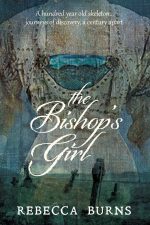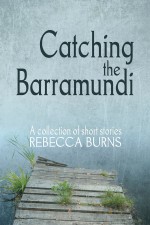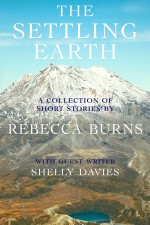Rebecca Burns is a prolific writer, having produced two short story collections, a novel, and written for several online and print journals, including The London Magazine, Per Contra and Menda City Press. Much of her work is set in isolated landscapes and explores the interconnectedness of humans and their environment. When not writing, Rebecca lives in Leicestershire with her young family.
What have you been up to since the release of The Bishop’s Girl?
I’ve been busy sending the book out for review, corresponding with lots of lovely bloggers and giving readings. It’s been hectic but lots of fun – I’ve really enjoyed engaging with readers and reviewers
 The Bishop’s Girl is your first novel, after releasing two short story collections. What’s your favourite part about writing a novel versus writing something shorter?
The Bishop’s Girl is your first novel, after releasing two short story collections. What’s your favourite part about writing a novel versus writing something shorter?
Great question! I really enjoy the technicality of short stories – mine are usually about 2500 words in length, so every single word has to count. One of the most satisfying aspects of short story writing is to create a world in microcosm, or to draw a character in only a few words. Ironically, exploring the depth of a character is also a favourite part of writing a novel! It’s challenging to put a character in a new situation and portray how they will react – there’s more scope and space to do this in a novel.
Although the novel is, in part, about a bishop, the focus is overwhelmingly on social welfare rather than religion. Was this a deliberate move on your part?
If, by social welfare, you mean human interactions and connectedness – yes, I wanted to explore in my book how a character seeks to define herself through her relations with others. Jess, one of the central characters of the novel, has come to a point in her life where she isn’t sure how she fits in anymore. Is she a wife, a mother, a researcher, an employee, a lover…or all of these things or none of them? Can she determine her own identity and what is important to her by shrugging off the expectations of others? I hope the book poses those questions and portrays how one character works towards her answers.
Across your work you explore the themes of isolation, both in remote communities and, in the case of The Bishop’s Girl, when the characters are surrounded by loved ones. What do you feel is so important about creating depictions of isolation and loss?
I think the complex notion of identity is something many writers explore and an attractive way, to me, to unpick such a theme is to remove a character from societal trappings – that could be by placing them on a deserted beach, or in the Australian Outback, or in the snowy Canadian landscape, or in colonial New Zealand. In these situations, my characters work towards defining a new reality. In The Settling Earth, settler women were removed from Victorian social mores and customs, and were free (if they were brave enough) to forge a new life for themselves. When a character is isolated, there is scope for the writer to explore how much cultural or social baggage they carry with them and how easily they can break free.
Sometimes great loss can cause emotional isolation – characters may be surrounded by people but a bereavement or upheaval has caused such rendering that they feel lost and alone. When I put characters in that situation, I do so in order to see how they sink or swim, and what life rafts they need – be they in the form of relationships, routines, drink…
 What inspired you to release your first collection, Catching the Barramundi?
What inspired you to release your first collection, Catching the Barramundi?
I loved the metaphor of a barramundi. It’s a fish that, on order to generate, changes sex from male to female. This idea of change and rupture fascinated me and many of my first published stories explored this theme. I pulled them together into a collection and thought I’d send them out into the world to see how they fared. I was chuffed when the book was longlisted for the Edge Hill Award, the UK’s only award for short story collections.
Short story collections are a bit of a dying breed. Why do you think that is?
I don’t know if it is a dying breed! I hope not! The great Alice Munro won the Nobel Prize for Literature in 2013 for her short stories and there are many wonderful collections out there. We should fight for short stories to remain popular – of course, I’m biased, but I love them.
The Settling Earth is a collaboration with Ngātiwai tribe member Shelly Davies. Tell us how that came about?
 When I wrote The Settling Earth, it was important to me to have a story that was written from a Maori perspective as, of course, the colonial experience was not just the preserve of white settlers. Colonisation affected the Maori population dramatically. I studied countless diaries and letters by settler women living in New Zealand for my PhD, and the material I read referred to settler’s interactions with Maori tribes only from the settler perspective. I wanted the Maori voice in The Settling Earth to be authentic and culturally sensitive, and felt a writer of Maori descent would be better placed than I to do that. I read many short stories by Maori writers and enjoyed Shelly Davies’ writing. I contacted her and we hit it off instantly – she was pleased to be part of the project and I’m delighted she contributed a story to The Settling Earth.
When I wrote The Settling Earth, it was important to me to have a story that was written from a Maori perspective as, of course, the colonial experience was not just the preserve of white settlers. Colonisation affected the Maori population dramatically. I studied countless diaries and letters by settler women living in New Zealand for my PhD, and the material I read referred to settler’s interactions with Maori tribes only from the settler perspective. I wanted the Maori voice in The Settling Earth to be authentic and culturally sensitive, and felt a writer of Maori descent would be better placed than I to do that. I read many short stories by Maori writers and enjoyed Shelly Davies’ writing. I contacted her and we hit it off instantly – she was pleased to be part of the project and I’m delighted she contributed a story to The Settling Earth.
Your work is set across a wide mix of environments – England, France, New Zealand and Australia, to name a few. How important is the idea of place to your work?
I love the interconnectedness of the landscape and a character. A landscape can ask questions of its characters – why is a person here, how will they react to a challenging environment, can they see anything of themselves in their topography? Place is important to me and very often I will imagine a setting or scene before seeing a character.
Describe your writing style in three words.
Evocative, compelling, engaging
Finally, what can fans expect to see from you next?
I am working on another novel, this time set in Berlin before the Wall came down. Life in the GDR fascinates me – it was a time of (sometimes enforced) social cohesiveness and was edged with fear and suspicion. That lends itself to all kinds of intrigue and I follow those paths in the novel. There’s a bit of time-travel, with characters negotiating the jarring distinctions between two very different ways of life. Maybe some romance thrown in, bit of action – I hope it will keep the reader engrossed! I’m about half way through of the first draft and need to knuckle down to get it done. But it’s a perfect excuse for a research trip…